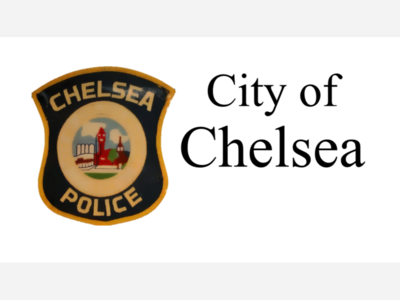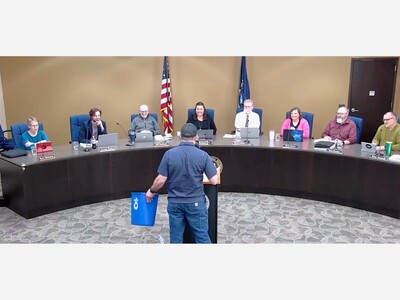Chelsea: 2023 Water Quality Report for City of Chelsea
2023 Water Quality Report for City of Chelsea
Once again, the City of Chelsea Water Department is pleased to submit the drinking water quality report for the 2023 calendar year. This information is a snapshot of the quality of the water that we provided to you in 2023. Included are details about where your water comes from, what it contains, and how it compares to Environmental Protection Agency (EPA) and state standards.
At present your tap water comes from three wells. Well #5, Well #6 and Well #7 are approximately 60 feet deep. The oldest of the three wells, well number 5 was drilled in 2000, following that was well 6 and 7 in 2007. These wells are what are commonly called “drift wells”, meaning that they are terminated in the glacial drift as opposed to being a rock well, which is set in the bedrock below the drift. The wells are in a gravel formation with a screen to allow water to pass through while keeping the sand and gravel from entering the pump.
The water from the three wells is pumped to the treatment plant where it moves through the aerators to oxidize the iron and manganese. After some detention time the water passes through the iron/manganese removal filters where the iron and manganese is removed. Once the water has passed through the iron removal filters it enters the membrane softening units. A portion of the iron treated water is diverted past the membrane softening equipment and blended with the softened water to balance the hardness and achieve a goal of 140 to 160 ppm or 8.18 to 9.36 gpg of hardness . The water then travels to the 200,000-gallon concrete ground storage tank located at the facility.
On its way to the ground storage tank chlorine is applied. The chlorine is added as a disinfectant to prevent the presence of any bacteriological contamination in the ground storage tank and piping. Approximately 0.50 ppm of fluoride is added with the naturally occurring fluoride of 0.20 ppm for healthier teeth and bones. Also added is a poly-phosphate blend to help prevent the corrosion of residential plumbing and distribution system piping. The water is metered and the chemicals are weighed every-day to ensure proper chemical dosages.
Source Water Vulnerability Assessment:
Your water comes from 3 groundwater wells, each over 50 feet deep. The State performed an assessment of our source water to determine the susceptibility or the relative potential of contamination. The susceptibility rating is on a seven-tiered scale from “very-low” to “very-high” based on geologic sensitivity, well construction, water chemistry and contamination sources. The susceptibility of our source is considered as having a high geological sensitivity.
Potential sources of contamination include groundwater discharge permit sites; several small and large quantity hazardous waste generator sites; several Underground Storage Tank sites; and hazardous waste facilities. Abandoned wells provide a direct conduit for surface runoff and contaminants to easily reach the groundwater and may pose a potential problem. We are making efforts to protect our sources by conducting an active Wellhead Protection Program that supports management of existing or potential sources of contamination in the Wellhead Protection Program Area. Known sources of contamination within the WHPA are being re mediated to prevent movement of contamination to the municipal wells. If you currently have or know of an abandoned well, please notify the Water Department or your local health department for guidelines on the procedure to cap the well head.
To obtain a copy of this report or request more information, please contact Corey Davis or John Powell at the City of Chelsea Water Department at 734-475-1771.
Contaminants and their presence in water: Drinking Water, including bottled water, may reasonably be expected to contain at least small amounts of some contaminants. The presence of contaminants does not necessarily indicate that water poses a health risk. More information about contaminants and potential health effects can be obtained by calling the EPA’s Safe Drinking Water Hotline (800-426-4791).
- Sources of drinking water: The sources of drinking water (both tap water and bottled water) include rivers, lakes, streams, ponds, reservoirs, springs, and wells. Our water comes from wells. As water travels over the surface of the land or through the ground, it dissolves naturally-occurring minerals and, in some cases, radioactive material, and can pick up substances resulting from the presence of animals or from human activity.
- · Contaminants that may be present in source water include:
- S Microbial contaminants, such as viruses and bacteria, which may come from sewage treatment plants, septic systems, agricultural livestock operations and wildlife.
- S Inorganic contaminants, such as salts and metals, which can be naturally-occurring or result from urban storm water runoff, industrial or domestic wastewater discharges, oil and gas production, mining or farming.
- S Pesticides and herbicides, which may come from a variety of sources such as agriculture and residential uses which may come from a variety of sources such as agricultural, urban storm-water runoff, and residential uses.
- S Radioactive contaminants, which are naturally occurring or be the result of oil and gas production and mining activities.
- S Organic chemical contaminants, including synthetic and volatile organic chemicals, which are by-products of industrial processes and petroleum production, and can also come from gas stations, urban storm water runoff, and septic systems.
- Vulnerability of sub-populations: Some people may be more vulnerable to contaminants in drinking water than the general population. Immune-compromised persons such as persons with cancer undergoing chemotherapy, persons who have undergone organ transplants, people with HIV/AIDS or other immune systems disorders, some elderly, and infants can be particularly at risk from infections. These people should seek advice about drinking water from their health care providers. EPA/CDC guidelines on appropriate means to lessen the risk of infection by Cryptosporidium and other microbial contaminants are available from the Safe Drinking Water Hotline (800-426-4791).
- Maximum Contaminant Level Goal (MCLG): The level of a contaminant in drinking water below which there is no known or expected risk to health. MCLGs allow for a margin of safety.
- Maximum Contaminant Level (MCL): The highest level of a contaminant that is allowed in drinking water. MCLs are set as close to the MCLGs as feasible using the best available treatment technology.
- Maximum Residual Disinfectant Level (MRDL): means the highest level of a disinfectant allowed in drinking water. There is convincing evidence that addition of a disinfectant is necessary for control of microbial contaminants.
- · Maximum Residual Disinfectant Level Goal (MRDLG): means the level of a drinking water disinfectant below which there is no known or expected risk to health. MRDLGs do not reflect the benefits of the use of disinfectants to control microbial contaminants.
- · N/A: Not applicable ND: not detectable at testing limit ppb: parts per billion or micrograms per liter ppm: parts per million or milligrams per liter pCi/L: picocuries per liter (a measure of radioactivity). gpg: grains per gallon
- · Action Level (AL): The concentration of a contaminant which, if exceeded, triggers treatment or other requirements that a water system must follow.
- · Treatment Technique (TT): A required process intended to reduce the level of a contaminant in drinking water.
- Running Annual Average (RAA) - Four quarter running annual average for chlorine residual in
In order to ensure that tap water is safe to drink, EPA prescribes regulations that limit the amount of certain contaminants in water provided by public water systems. Food and Drug Administration regulations establish limits for contaminants in bottled water which provide the same protection for public health.
Water Quality Data
The table below lists all the drinking water contaminants that we detected during the 2023 calendar year. The presence of these contaminants in the water does not necessarily indicate that the water poses a health risk. Unless otherwise noted, the data presented in this table is from testing done January 1 – December 31, 2023. The State allows us to monitor for certain contaminants less than once per year because the concentrations of these contaminants are not expected to vary significantly from year to year. All of the data is representative of the water quality, but some are more than one year old.
Terms and abbreviations used below:
the distribution system.
All results are in parts per million (ppm) unless otherwise noted
PLANT TAP |
||||||||||
RegulatedContaminant |
MCL |
MCLG |
YourWater |
Reporting Limit |
Sample Date |
Violation |
Typical Source of Contaminant |
|||
|
Copper |
1.3 |
1.3 |
0.12 |
0.05 |
06/05/19 |
No |
Corrosion of household plumbing systems; Erosion of natural deposits; Leaching from wood preservatives |
|||
|
Iron |
ND |
0.01 |
7/15/21 |
No |
Erosion of natural deposits |
|||||
|
Barium |
2 |
2 |
0.09 |
NA |
06/05/19 |
No |
Drilling waste discharge, metal refinery discharges, erosion of natural deposits. |
|||
|
Fluoride |
4 |
4 |
0.52 |
0.1 |
06/16/23 |
No |
Erosion of natural deposits. Discharge from fertilizer and aluminum factories. |
|||
Special Monitoring andUnregulated Contaminant * |
YourWater |
Reporting Limit |
Sample Date / freq. |
Typical Source of Contaminant |
||||||
|
Chloride (ppm) average |
39.40 |
4 |
Every two weeks |
Erosion of natural deposits |
||||||
|
Sodium (automated) (ppm) |
32 |
0.5 |
06/22/23 |
Erosion of natural deposits |
||||||
|
Sulfate (ppm) average |
25.16 |
10 |
Every two weeks |
Erosion of natural deposits |
||||||
|
Hardness as CaCO3 (ppm) |
160 |
2 |
Weekly |
Erosion of natural deposits |
||||||
|
Calcium (ppm) |
76 |
0.6 |
06/22/23 |
Erosion of natural deposits |
||||||
|
Magnesium (ppm) |
20 |
0.1 |
06/22/23 |
Erosion of natural deposits |
||||||
|
Bromodichloromethane (ppm) |
0.0010 |
0.0005 |
7/15/21 |
Byproduct of drinking water disinfection |
||||||
|
Bromoform (ppm) |
0.0017 |
0.0005 |
7/15/21 |
Byproduct of drinking water disinfection |
||||||
|
Chlorodibromomethane (ppm) |
0.0020 |
0.0005 |
7/15/21 |
Byproduct of drinking water disinfection |
||||||
|
Total Trihalomethanes (ppm) |
0.0047 |
NA |
7/15/21 |
Byproduct of drinking water disinfection |
||||||
|
|
|
|||||||||
|
|
DISTRIBUTION |
|||||||||
Disinfection andDisinfectionby-products |
MCL |
MCLG |
YourWater |
Reporting Limit |
SampleDate |
ViolationYes / No |
Typical Source of Contaminant |
|||
|
TTHM - Total |
80 |
N/A |
15.8 |
0.5 |
06/16/23 |
No |
Byproduct of drinking water disinfection |
|||
|
Bromodichlorometh-ane (ppb) |
80 |
N/A |
4.5 |
0.5 |
06/16/23 |
No |
Byproduct of drinking water disinfection |
|||
|
Bromoform (ppb) |
80 |
N/A |
3.1 |
0.5 |
06/16/23 |
No |
Byproduct of drinking water disinfection |
|||
|
Chlorodibromometh-ane (ppb) |
80 |
N/A |
6.2 |
0.5 |
06/16/23 |
No |
Byproduct of drinking water disinfection |
|||
|
Chloroform (ppb) |
80 |
N/A |
2.0 |
0.5 |
06/16/23 |
No |
Byproduct of drinking water disinfection |
|||
|
Chlorine |
MRDL |
MRDLG |
0.5 |
0.33 - 0.80 |
Monthly |
No |
Water additive used to control microbes |
|||
|
4 |
4 |
|||||||||
|
Inorganic Contaminant Subject to Action Levels (AL) |
Action Level |
MCLG |
Your Water |
Range of Results |
Year Sampled |
Number of Samples Above AL |
Typical Source of Contaminant |
|
Lead (ppb) |
15 |
0 |
0 |
0 ppb – 0 ppb |
2023 |
0 |
Lead service lines, corrosion of household plumbing including fittings and fixtures; Erosion of natural deposits |
|
Copper (ppm) |
1.3 |
1.3 |
0.5 ppm |
0 ppm – 0.9 ppm |
2023 |
0 |
Corrosion of household plumbing systems; Erosion of natural deposits. |
*Unregulated contaminants are those for which EPA has not established drinking water standards. Monitoring helps EPA to determine where these contaminants occur and whether it needs to regulate those contaminants.
Lead in your drinking water; if present, elevated levels of lead can cause serious health problems, especially for pregnant women and young children. Lead in drinking water is primarily from materials and components associated with service lines and home plumbing. The City of Chelsea is responsible for providing high quality drinking water, but cannot control the variety of materials used in plumbing components. When your water has been sitting for several hours you can minimize the potential for lead exposure by flushing your tap for 30 seconds to 2 minutes before using water for drinking or cooking. If you are concerned about lead in your water, you may wish to have your water tested. Information on lead in drinking water, testing methods and steps you can take to minimize exposure is available from the Safe Drinking Water Hotline at 1-800-426-4791 or at http://water.epa.gov/drink/info/lead.
Monitoring and Reporting Requirements: The State and EPA require us to test our water on a regular basis to ensure its safety. The City of Chelsea Water Department met all the monitoring and reporting requirements for 2023. We will update this report annually. Copies are available at the City of Chelsea Offices and on the City website or by contacting the City of Chelsea Water Department at 734-475-1771.
We invite public participation in decisions that affect drinking water quality. The Chelsea City Council meetings are held the First and Third Monday of each month at 7:00 pm. For more information about your water, or the contents of this report, contact City of Chelsea Water Department. For more information about safe drinking water, visit the U.S. Environmental Protection Agency at www.epa.gov/safewater/.














